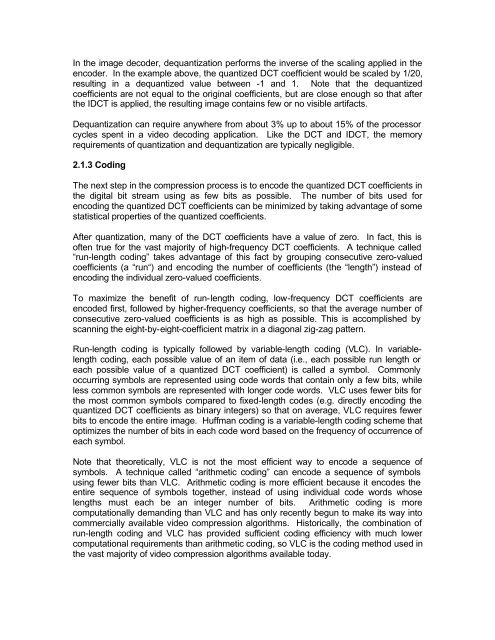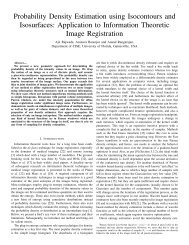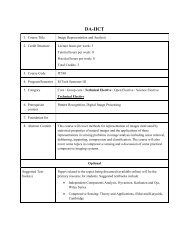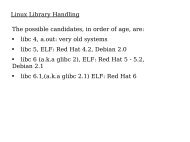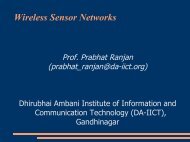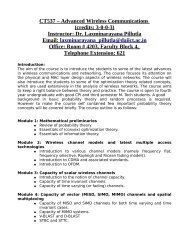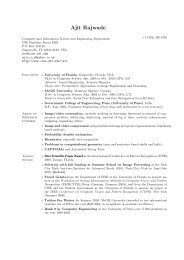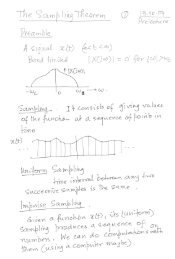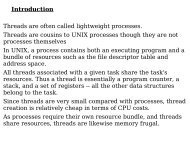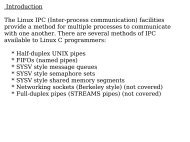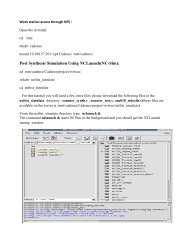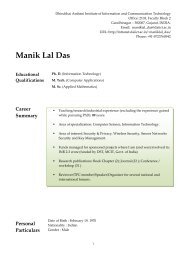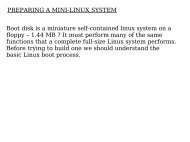ESC-210: Introduction to Video Compression - DAIICT Intranet
ESC-210: Introduction to Video Compression - DAIICT Intranet
ESC-210: Introduction to Video Compression - DAIICT Intranet
You also want an ePaper? Increase the reach of your titles
YUMPU automatically turns print PDFs into web optimized ePapers that Google loves.
In the image decoder, dequantization performs the inverse of the scaling applied in the<br />
encoder. In the example above, the quantized DCT coefficient would be scaled by 1/20,<br />
resulting in a dequantized value between -1 and 1. Note that the dequantized<br />
coefficients are not equal <strong>to</strong> the original coefficients, but are close enough so that after<br />
the IDCT is applied, the resulting image contains few or no visible artifacts.<br />
Dequantization can require anywhere from about 3% up <strong>to</strong> about 15% of the processor<br />
cycles spent in a video decoding application. Like the DCT and IDCT, the memory<br />
requirements of quantization and dequantization are typically negligible.<br />
2.1.3 Coding<br />
The next step in the compression process is <strong>to</strong> encode the quantized DCT coefficients in<br />
the digital bit stream using as few bits as possible. The number of bits used for<br />
encoding the quantized DCT coefficients can be minimized by taking advantage of some<br />
statistical properties of the quantized coefficients.<br />
After quantization, many of the DCT coefficients have a value of zero. In fact, this is<br />
often true for the vast majority of high-frequency DCT coefficients. A technique called<br />
“run-length coding” takes advantage of this fact by grouping consecutive zero-valued<br />
coefficients (a “run“) and encoding the number of coefficients (the “length”) instead of<br />
encoding the individual zero-valued coefficients.<br />
To maximize the benefit of run-length coding, low-frequency DCT coefficients are<br />
encoded first, followed by higher-frequency coefficients, so that the average number of<br />
consecutive zero-valued coefficients is as high as possible. This is accomplished by<br />
scanning the eight-by-eight-coefficient matrix in a diagonal zig-zag pattern.<br />
Run-length coding is typically followed by variable-length coding (VLC). In variablelength<br />
coding, each possible value of an item of data (i.e., each possible run length or<br />
each possible value of a quantized DCT coefficient) is called a symbol. Commonly<br />
occurring symbols are represented using code words that contain only a few bits, while<br />
less common symbols are represented with longer code words. VLC uses fewer bits for<br />
the most common symbols compared <strong>to</strong> fixed-length codes (e.g. directly encoding the<br />
quantized DCT coefficients as binary integers) so that on average, VLC requires fewer<br />
bits <strong>to</strong> encode the entire image. Huffman coding is a variable-length coding scheme that<br />
optimizes the number of bits in each code word based on the frequency of occurrence of<br />
each symbol.<br />
Note that theoretically, VLC is not the most efficient way <strong>to</strong> encode a sequence of<br />
symbols. A technique called “arithmetic coding” can encode a sequence of symbols<br />
using fewer bits than VLC. Arithmetic coding is more efficient because it encodes the<br />
entire sequence of symbols <strong>to</strong>gether, instead of using individual code words whose<br />
lengths must each be an integer number of bits. Arithmetic coding is more<br />
computationally demanding than VLC and has only recently begun <strong>to</strong> make its way in<strong>to</strong><br />
commercially available video compression algorithms. His<strong>to</strong>rically, the combination of<br />
run-length coding and VLC has provided sufficient coding efficiency with much lower<br />
computational requirements than arithmetic coding, so VLC is the coding method used in<br />
the vast majority of video compression algorithms available <strong>to</strong>day.


